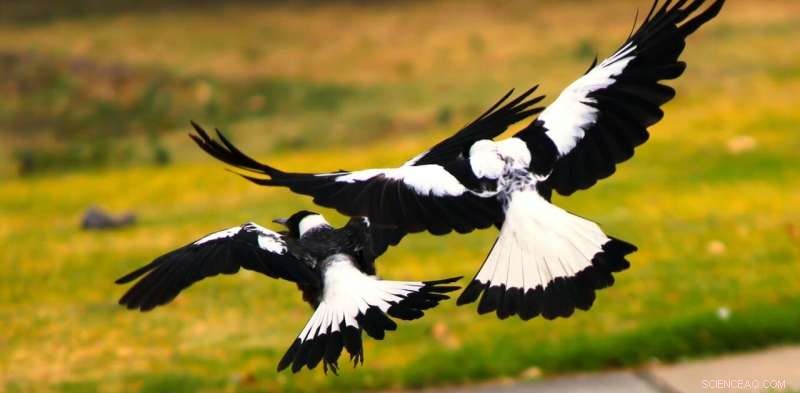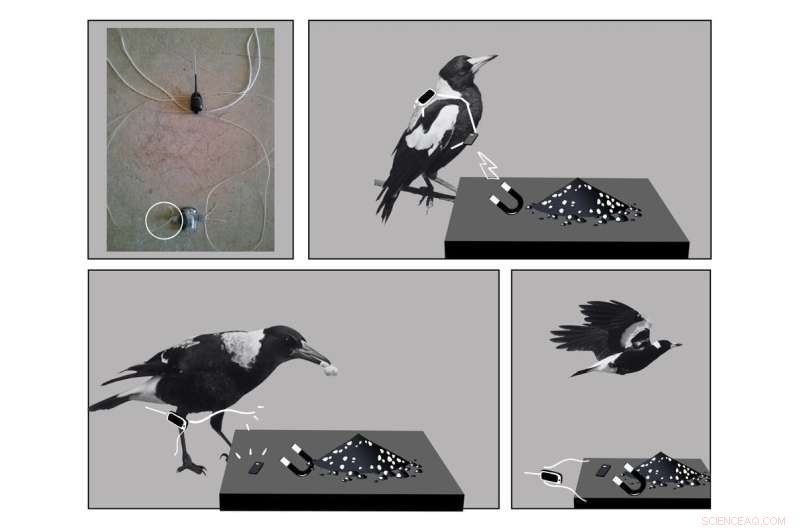
Crédit :Shutterstock
Lorsque nous avons attaché de minuscules dispositifs de suivi en forme de sac à dos à cinq pies australiennes pour une étude pilote, nous ne nous attendions pas à découvrir un comportement social entièrement nouveau rarement observé chez les oiseaux.
Notre objectif était d'en savoir plus sur le mouvement et la dynamique sociale de ces oiseaux très intelligents, et de tester ces nouveaux appareils durables et réutilisables. Au lieu de cela, les oiseaux nous ont déjoués.
Comme l'explique notre nouveau document de recherche, les pies ont commencé à montrer des signes de comportement coopératif de "sauvetage" pour s'entraider à retirer le traqueur.
Bien que nous sachions que les pies sont des créatures intelligentes et sociales, c'est le premier cas à notre connaissance qui montre ce type de comportement apparemment altruiste :aider un autre membre du groupe sans obtenir de récompense immédiate et tangible.
Tester de nouveaux appareils passionnants
En tant que scientifiques universitaires, nous sommes habitués à ce que les expériences tournent mal d'une manière ou d'une autre. Des substances périmées, des équipements défaillants, des échantillons contaminés, une panne de courant imprévue, tout cela peut retarder des mois (voire des années) de recherches soigneusement planifiées.
Pour ceux d'entre nous qui étudient les animaux, et en particulier le comportement, l'imprévisibilité fait partie de la description du poste. C'est la raison pour laquelle nous avons souvent besoin d'études pilotes.

L'un des trackers que nous avons attaché à cinq pies, qui pèse moins d'un gramme. Crédit :Dominique Potvin, Auteur fourni
Notre étude pilote a été l'une des premières du genre - la plupart des trackers sont trop grands pour tenir sur des oiseaux de taille moyenne à petite, et ceux qui le font ont tendance à avoir une capacité très limitée pour le stockage des données ou la durée de vie de la batterie. Ils ont également tendance à être à usage unique.
Un nouvel aspect de notre recherche était la conception du harnais qui retenait le tracker. Nous avons conçu une méthode qui n'exigeait pas que les oiseaux soient à nouveau capturés pour télécharger des données précieuses ou réutiliser les petits appareils.
Nous avons formé un groupe de pies locales pour qu'elles se rendent à une "station" d'alimentation au sol en plein air qui pourrait soit charger sans fil la batterie du tracker, télécharger des données, soit libérer le tracker et le harnais à l'aide d'un aimant.
Le harnais était solide, avec un seul point faible où l'aimant pouvait fonctionner. Pour enlever le harnais, il fallait cet aimant ou de très bons ciseaux. Nous avons été enthousiasmés par la conception, car elle ouvrait de nombreuses possibilités d'efficacité et permettait de collecter de nombreuses données.
We wanted to see if the new design would work as planned, and discover what kind of data we could gather. How far did magpies go? Did they have patterns or schedules throughout the day in terms of movement, and socialising? How did age, sex or dominance rank affect their activities?
All this could be uncovered using the tiny trackers—weighing less than one gram—we successfully fitted five of the magpies with. All we had to do was wait, and watch, and then lure the birds back to the station to gather the valuable data.
It was not to be
Many animals that live in societies cooperate with one another to ensure the health, safety and survival of the group. In fact, cognitive ability and social cooperation has been found to correlate. Animals living in larger groups tend to have an increased capacity for problem solving, such as hyenas, spotted wrasse, and house sparrows.
Australian magpies are no exception. As a generalist species that excels in problem solving, it has adapted well to the extreme changes to their habitat from humans.
Australian magpies generally live in social groups of between two and 12 individuals, cooperatively occupying and defending their territory through song choruses and aggressive behaviors (such as swooping). These birds also breed cooperatively, with older siblings helping to raise young.
During our pilot study, we found out how quickly magpies team up to solve a group problem. Within ten minutes of fitting the final tracker, we witnessed an adult female without a tracker working with her bill to try and remove the harness off of a younger bird.
Within hours, most of the other trackers had been removed. By day 3, even the dominant male of the group had its tracker successfully dismantled.
We don't know if it was the same individual helping each other or if they shared duties, but we had never read about any other bird cooperating in this way to remove tracking devices.

Our new tracker design was innovative, allowing a magnet to release the harness. Credit:Dominique Potvin, Author provided
The birds needed to problem solve, possibly testing at pulling and snipping at different sections of the harness with their bill. They also needed to willingly help other individuals, and accept help.
The only other similar example of this type of behavior we could find in the literature was that of Seychelles warblers helping release others in their social group from sticky Pisonia seed clusters. This is a very rare behavior termed "rescuing."
Saving magpies
So far, most bird species that have been tracked haven't necessarily been very social or considered to be cognitive problem solvers, such as waterfowl and raptors. We never considered the magpies may perceive the tracker as some kind of parasite that requires removal.
Tracking magpies is crucial for conservation efforts, as these birds are vulnerable to the increasing frequency and intensity of heatwaves under climate change.
In a study published this week, Perth researchers showed the survival rate of magpie chicks in heatwaves can be as low as 10%.
Importantly, they also found that higher temperatures resulted in lower cognitive performance for tasks such as foraging. This might mean cooperative behaviors become even more important in a continuously warming climate.
Just like magpies, we scientists are always learning to problem solve. Now we need to go back to the drawing board to find ways of collecting more vital behavioral data to help magpies survive in a changing world.